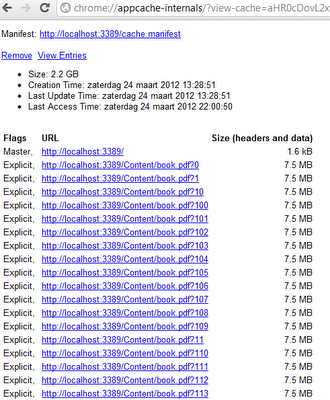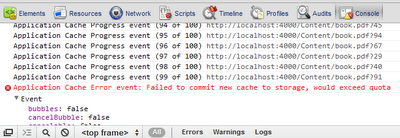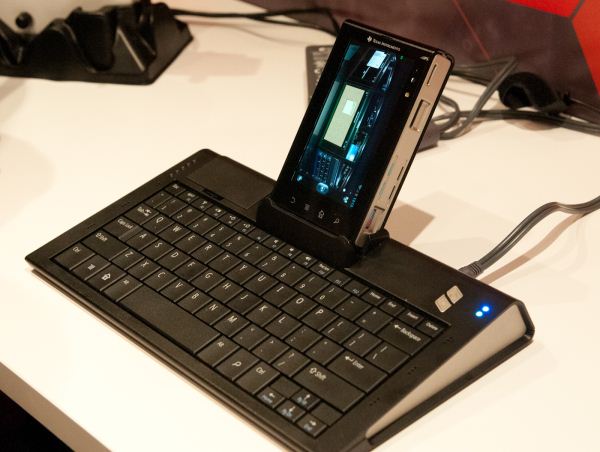Wednesday, April 04. 2012
8 bits wide world
Tuesday, April 03. 2012
Cracking the cloud: An Amazon Web Services primer
Via ars technica
-----

It's nice to imagine the cloud as an idyllic server room—with faux grass, no less!—but there's actually far more going on than you'd think.
Maybe you're a Dropbox devotee. Or perhaps you really like streaming Sherlock on Netflix. For that, you can thank the cloud.
In fact, it's safe to say that Amazon Web Services (AWS) has become synonymous with cloud computing; it's the platform on which some of the Internet's most popular sites and services are built. But just as cloud computing is used as a simplistic catchall term for a variety of online services, the same can be said for AWS—there's a lot more going on behind the scenes than you might think.
If you've ever wanted to drop terms like EC2 and S3 into casual conversation (and really, who doesn't?) we're going to demystify the most important parts of AWS and show you how Amazon's cloud really works.
Elastic Cloud Compute (EC2)
Think of EC2 as the computational brain behind an online application or service. EC2 is made up of myriad instances, which is really just Amazon's way of saying virtual machines. Each server can run multiple instances at a time, in either Linux or Windows configurations, and developers can harness multiple instances—hundreds, even thousands—to handle computational tasks of varying degrees. This is what the elastic in Elastic Cloud Compute refers to; EC2 will scale based on a user's unique needs.
Instances can be configured as either Windows machines, or with various flavors of Linux. Again, each instance comes in different sizes, depending on a developer's needs. Micro instances, for example, only come with 613 MB of RAM, while Extra Large instances can go up to 15GB. There are also other configurations for various CPU or GPU processing needs.
Finally, EC2 instances can be deployed across multiple regions—which is really just a fancy way of referring to the geographic location of Amazon's data centers. Multiple instances can be deployed within the same region (on separate blocks of infrastructure called availability zones, such as US East-1, US East-2, etc.), or across more than one region if increased redundancy and reduced latency is desired
Elastic Load Balance (ELB)
Another reason why a developer might deploy EC2 instances across multiple availability zones and regions is for the purpose of load balancing. Netflix, for example, uses a number of EC2 instances across multiple geographic location. If there was a problem with Amazon's US East center, for example, users would hopefully be able to connect to Netflix via the service's US West instances instead.
But what if there is no problem, and a higher number of users are connecting via instances on the East Coast than on the West? Or what if something goes wrong with a particular instance in a given availability zone? Amazon's Elastic Load Balance allows developers to create multiple EC2 instances and set rules that allow traffic to be distributed between them. That way, no one instance is needlessly burdened while others idle—and when combined with the ability for EC2 to scale, more instances can also be added for balance where required.
Elastic Block Storage (EBS)
Think of EBS as a hard drive in your computer—it's where an EC2 instance stores persistent files and applications that can be accessed again over time. An EBS volume can only be attached to one EC2 instance at a time, but multiple volumes can be attached to the same instance. An EBS volume can range from 1GB to 1TB in size, but must be located in the same availability zone as the instance you'd like to attach to.
Because EC2 instances by default don't include a great deal of local storage, it's possible to boot from an EBS volume instead. That way, when you shut down an EC2 instance and want to re-launch it at a later date, it's not just files and application data that persist, but the operating system itself.
Simple Storage Service (S3)
Unlike EBS volumes, which are used to store operating system and application data for use with an EC2 instance, Amazon's Simple Storage Service is where publicly facing data is usually stored instead. In other words, when you upload a new profile picture to Twitter, it's not being stored on an EBS volume, but with S3.
S3 is often used for static content, such as videos, images or music, though virtually anything can be uploaded and stored. Files uploaded to S3 are referred to as objects, which are then stored in buckets. As with EC2, S3 storage is scalable, which means that the only limit on storage is the amount of money you have to pay for it.
Buckets are also stored in regions, and within that region “are redundantly stored on multiple devices across multiple facilities.” However, this can cause latency issues if a user in Europe is trying to access files stored in a bucket within the US West region, for example. As a result, Amazon also offers a service called CloudFront, which allows objects to be mirrored across other regions.
While these are the core features that make up Amazon Web Services, this is far from a comprehensive list. For example, on the AWS landing page alone, you'll find things such as DynamoDB, Route53, Elastic Beanstalk, and other features that would take much longer to detail here.
However, if you've ever been confused about how the basics of AWS work—specifically, how computational data and storage is provisioned and scaled—we hope this gives you a better sense of how Amazon's brand of cloud works.
Correction: Initially, we confused regions in AWS with availability zones. As Mhj.work explains in the comments of this article, "availability Zones are actually "discrete" blocks of infrastructure ... at a single geographical location, whereas the geographical units are called Regions. So for example, EU-West is the Region, whilst EU-West-1, EU-West-2, and EU-West-3 are Availability Zones in that Region." We have updated the text to make this point clearer.
Monday, April 02. 2012
Suddenly Microsoft is the Hippest Tech Company Around
-----
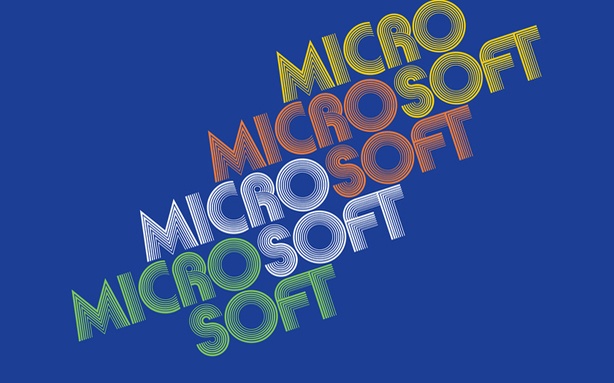
flickr/Jeff Dlouhy
While Apple and Google are busy getting bad press for their privacy issues, labor practices and general big-evil-company wrongdoings, Microsoft has done some brand regeneration, making it look like the hippest tech company on the block these days. As Apple and Google captured a younger, cooler demographic, the Windows maker, with its stodgy business oriented PC-compatible operating system and notoriously annoying browser, became synonymous with lameness. Remember all those highly effective Mac versus PC commercials? That PC dork (writer-performer John Hodgman) represented all things Microsoft: Slow, uptight, badly dressed. But as Apple and Google have grown up, they've lost their hip sheen. And, Microsoft's taking advantage. In this era of awesomely bad, it doesn't look so lame anymore -- especially in comparison to the other guys.
We noticed this new-found hipness when we came across the endearing Browser You Love(d) to Hate campaign. With some admirable self-awareness, Microsoft used its own bad reputation to argue that its hated Internet Explorer browser is on the verge of a comeback. Layering on the hipster-irony, Microsoft compares itself to once-passe things like PBR and mustaches, suggesting it's just another brand that's so bad, it's cool again. It also doesn't hurt that the overall look of the site matches that aesthetic. The Atlantic's own mustachio-ed tech man, Alexis Madrigal gave it his approval, calling this accompanying ad "definitely the funniest commercial Microsoft's ever put out." We agreed, finding the whole thing convincing enough to give our abandoned IE9 a try again. (We still prefer Chrome, by the way.)
But this image comeback isn't limited to IE. Over the last few days we've seen Hotmail ads running on Boing Boing and Jezebel, two blogs that are hip for different reasons. Boing Boing catering to the hippest of Internet lovers and Jezebel reaches a more mainstream but still cool millennial audience. And in general, the overall Microsoft-related press has been kind of good. Windows 8 surprised and excited the tech blogger world, something a Windows browser hasn't done since Windows 95. The company has some other exciting things going on inside its labs. The other day, It did some Internet good with its Digital Crimes Unit. And, has even designed itself a decent looking logo. Apple's (maybe) new logo, on the other hand, with its rainbow mish-mash, feels dated.
Which brings us to the other aspect of Microsoft's renaissance: good timing. The once-hipper than Microsoft foes, Google and Apple haven't looked so good these days. Google, the once beloved search company, has users uneasy with its Google+ integration, privacy issues and anti-trust concerns. Even Googlers aren't too sure of Google's mission, these days. Appl still produces insane-popular gadgets, but no longer wows reviewers like it once did. The new iPad is still the best tablet out there, but it's not a must-have. Plus, it too has gotten itself into its own privacy messes. It also had the misfortune of acting as the face of the last few months of Foxconn scandal. Though the Foxconn protesters that threatened mass suicide back in January made Microsoft's XBox, thanks to Mike Daisey and Apple's financial successes, Apple not Microsoft absorbed most of the bad PR.
Part of this has to do with maturity, we suppose. An early bloomer, Microsoft's already went through its tech company growing pains. It used to be the evil one, remember? The one accused of monopolistic practices, of buying up the competition, of stifling innovation. But it's no longer the bully. Google and Apple's misdeeds have overshadowed the once dominant tech company, and while the other big players make public messes out of themselves, Microsoft looks to be cleaning up its image. And, we have to say, it looks good.
Friday, March 30. 2012
Fake ID holders beware: facial recognition service Face.com can now detect your age
Via VB
-----
Facial-recognition platform Face.com could foil the plans of all those under-age kids looking to score some booze. Fake IDs might not fool anyone for much longer, because Face.com claims its new application programming interface (API) can be used to detect a person’s age by scanning a photo.
With its facial recognition system, Face.com has built two Facebook apps that can scan photos and tag them for you. The company also offers an API for developers to use its facial recognition technology in the apps they build.
Its latest update to the API can scan a photo and supposedly determine a person’s minimum age, maximum age, and estimated age. It might not be spot-on accurate, but it could get close enough to determine your age group.
“Instead of trying to define what makes a person young or old, we provide our algorithms with a ton of data and the system can reverse engineer what makes someone young or old,” Face.com chief executive Gil Hirsch told VentureBeat in an interview. ”We use the general structure of a face to determine age. As humans, our features are either heighten or soften depending on the age. Kids have round, soft faces and as we age, we have elongated faces.”
The algorithms also take wrinkles, facial smoothness, and other telling age signs into account to place each scanned face into a general age group. The accuracy, Hirsch told me, is determined by how old a person looks, not necessarily how old they actually are. The API also provides a confidence level on how well it could determine the age, based on image quality and how the person looks in photo, i.e. if they are turned to one side or are making a strange face.

“Adults are much harder to figure out [their age], especially celebrities. On average, humans are much better at detecting ages than machines,” said Hirsch.
The hope is to build the technology into apps that restrict or tailor content based on age. For example the API could be built into a Netflix app, scan a child’s face when they open the app, determine they’re too young to watch The Hangover, and block it. Or — and this is where the tech could get futuristic and creepy — a display with a camera could scan someone’s face when they walk into a store and deliver ads based on their age.
In addition to the age-detection feature, Face.com says it has updated its API with 30 percent better facial recognition accuracy and new recognition algorithms. The updates were announced Thursday and the API is available for any developer to use.
One developer has already used the API to build app called Age Meter, which is available in the Apple App Store. On its iTunes page, the entertainment-purposes-only app shows pictures of Justin Bieber and Barack Obama with approximate ages above their photos.
Other companies in this space include Cognitec, with its FaceVACS software development kit, and Bayometric, which offers FaceIt Face Recognition. Google has also developed facial-recognition technology for Android 4.0 and Apple applied for a facial recognition patent last year.
The technology behind scanning someone’s picture, or even their face, to figure out their age still needs to be developed for complete accuracy. But, the day when bouncers and liquor store cashiers can use an app to scan a fake ID’s holder’s face, determine that they are younger than the legal drinking age, and refuse to sell them wine coolers may not be too far off.
EU Votes To Lower Mobile Roaming Charges
Via CIO TODAY
-----
Business travelers -- and the enterprises that foot their phone bills -- have been complaining about high roaming fees in Europe for years. Now, some relief is finally in sight.
Indeed, both data roaming and phone calls travelers make while doing business (or taking a vacation) in Europe should be much cheaper this summer thanks to a deal done in the European Parliament this week.
Members of the European Parliament and the Danish Presidency of the Council of Ministers agreed to lower price caps on roaming. Parliament as a whole still needs to approve the deal. But if all runs smoothly the new rules will take effect July 1.
"I am satisfied that the Council approved Parliament's approach to tackle very high prices of phone calls, SMS and in particular of data roaming," said Angelika Niebler of Germany, Parliament's reporter for the draft legislation. "The proposed price caps ensure a sufficient margin between wholesale and retail prices to assure a level of competition that will enable new players to enter the market."
How Low Do They Go?
The agreement increases transparency and consumer protection to prevent bill shocks, Niebler said. That means European Union consumers no longer need to worry about accidentally running up huge bills when using their mobile devices both within and outside the EU. Of course, it's also a boon for consumers from other nations traveling to Europe.
How much savings are we talking about? According to the new rules, a downloaded megabyte would cost no more than 70 cents. That cost drops down to 45 cents in 2013 and 20 cents by July 2014. This is a big improvement, seeing as there is currently no price ceiling for mobile data services charged to consumers.
On the phone call front, the cost of a one-minute call would not exceed 29 cents under the new rules. That declines to 19 cents as of July 2014. That's down from 35 cents under the current legislation. Finally, an SMS would cost no more than 9 cents. That drops to 6 cents as by July 2014 and marks an 11 percent cut from current costs.
Nixing Roaming Altogether
"Mobile roaming charges in the EU are artificially high. Given the fact that they are trying to treat the entire continent like a single country, I don't understand why mobile roaming charges are so high between countries," said Mike Disabato, managing vice president of network and telecom at Gartner.
Practically speaking, the new rules mean that you only need one SIM card while traveling in Europe. Of course, you can't get a SIM card on an iPhone unless you buy an unlocked phone for $800. But if you do use a SIM card you will not have to change phone numbers every time you go to a different country.
"The new rules will make it a lot cheaper for people who actually have to do business in Europe. Any time you start reducing these types of rates it's a good thing," Disabato said. "We got rid of roaming charges a long time ago. It's about time they go in Europe. It will take until the EU decides they are going to make it happen."TRON... in 219 bytes
Via Christian Babski
-----

You can have an explanation from the authors of this short piece of code.
Or just play it (i, j, k or l to start)
How a web application can download and store over 2GB without you even knowing it
Via Jef Claes
-----
I have been experimenting with the HTML5 offline application cache some more over the last few days, doing boundary tests in an attempt to learn more about browser behaviour in edge cases.
One of these experiments was testing the cache quota.
Two weeks ago, I blogged about generating and serving an offline application manifest using ASP.NET MVC. I reused that code to add hundreds of 7MB PDF files to the cache.
public ActionResult Manifest() { var cacheResources = new List<string>(); var n = 300; // Play with this number for (var i = 0; i < n; i++) cacheResources.Add("Content/" + Url.Content("book.pdf?" + i)); var manifestResult = new ManifestResult("1") { NetworkResources = new string[] { "*" }, CacheResources = cacheResources }; return manifestResult; }I initially tried adding 1000 PDF files to the cache, but this threw an error: Chrome failed to commit the new cache to the storage, because the quota would be exceeded.
After lowering the number of files several times, I hit the sweet spot. I could add 300 PDF files to the cache without breaking it.
Something else I noticed, is that other sites now fail to commit anything to the application cache due to the browser-wide quota being exceeded. I'm pretty sure this 'first browsed, first reserved' approach will be a source of frustration in the future.
To handle this scenario we could use the applicationCache API to listen for quota errors, and inform the user to browse to chrome://appcache-internals/ and remove other caches in favor of the new one. This feels sketchy though; shouldn't the browser intervene in a more elegant way here?
Thursday, March 29. 2012
LG flexible epaper devices promised for April launch
Via Slash Gear
-----
LG Display has launched a new, 6-inch flexible epaper display that the company expects to show up in bendable products by the beginning of next month. The panel, a 1024 x 768 monochrome sheet, can be bent up to 40-degrees without breaking; in addition, because LG Display has used a flexible plastic substrate rather than the more traditional glass, it’s less than half the weight of a traditional epaper panel.
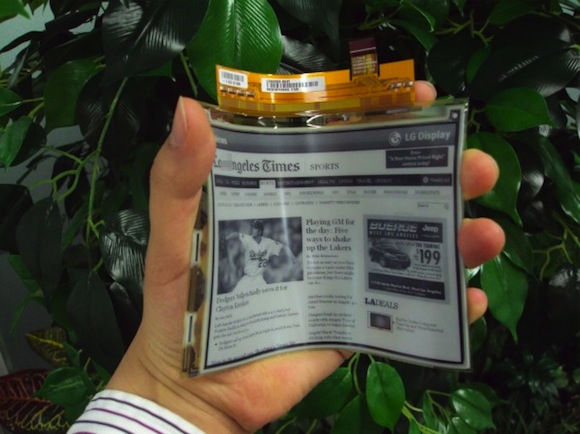
That means lighter gadgets that are actually more durable since the panels should be more resilient to drops or bumps. They can also be thinner, too: the plastic panel is a third slimmer than glass equivalents, at just 0.7mm thick.
LG Display says it can drop its new screen from 1.5m – the average height a device is held when it’s being used for reading, apparently – without any resulting damage. The company also hit the screen with a plastic hammer, leaving no scratches or breaks, ETNews reports.
LG isn’t the only company to be working on flexible screens this year. Samsung has already confirmed that it is looking at launching devices using flexible AMOLED panels in 2012, though it’s unclear whether the screens will actually fold or bend, or simply be used to wrap around smartphones for new types of UI.
The first products using the LG Display flexible panel are on track for a release in the European market in early April, the company claims. No word on what vendors will be offering them, nor how pricing will compare to traditional glass-substrate epaper.
Wednesday, March 28. 2012
Anatomy of a leak: how iPhones spill the ID of networks they access
Via ars technica
-----
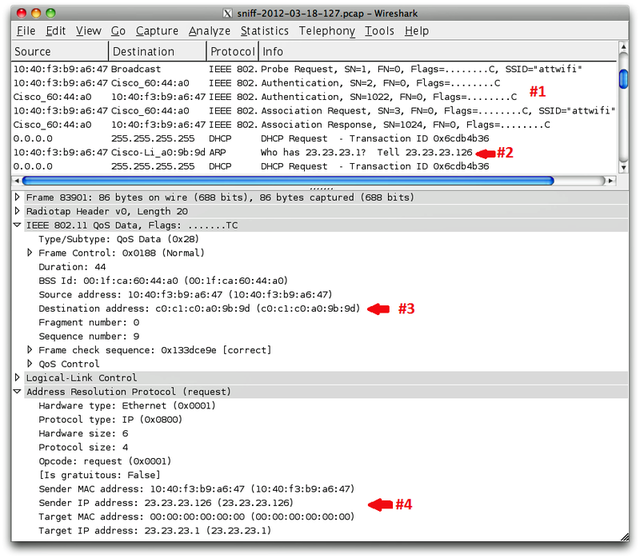
An Ars story from earlier this month reported that iPhones expose the unique identifiers of recently accessed wireless routers, which generated no shortage of reader outrage. What possible justification does Apple have for building this leakage capability into its entire line of wireless products when smartphones, laptops, and tablets from competitors don't? And how is it that Google, Wigle.net, and others get away with publishing the MAC addresses of millions of wireless access devices and their precise geographic location?
Some readers wanted more technical detail about the exposure, which applies to three access points the devices have most recently connected to. Some went as far as to challenge the validity of security researcher Mark Wuergler's findings. "Until I see the code running or at least a youtube I don't believe this guy has the goods," one Ars commenter wrote.
According to penetration tester Robert Graham, the findings are legit.
In the service of our readers, and to demonstrate to skeptics that the privacy leak is real, Ars approached Graham and asked him to review the article for accuracy and independently confirm or debunk Wuergler's findings.
"I can confirm all the technical details of this 'hack,'" Graham, who is CEO of Errata Security, told Ars via e-mail. "Apple products do indeed send out three packets that will reveal your home router MAC address. I confirmed this with my latest iPad 3."
He provided the image at the top of this post as proof. It shows a screen from Wireshark, a popular packet-sniffing program, as his iPad connected to a public hotspot at a Starbucks in Atlanta. Milliseconds after it connected to an SSID named "attwifi" (as shown in the section labeled #1), the iPad broadcasted the MAC address of his Linksys home router (shown in the section labeled #2). In section #3, the iPad sent the MAC address of this router a second time, and curiously, the identifier was routed to this access point even though it's not available on the local network. As is clear in section #4, the iPad also exposed the local IP address the iPad used when accessing Graham's home router. All of this information is relatively simple to view by anyone within radio range.
The image is consistent with one provided by Wuergler below. Just as Wuergler first claimed, it shows an iPhone disclosing the last three access points it has connected to.

Graham used Wireshark to monitor the same Starbucks hotspot when he connected with his Windows 7 laptop and Android-based Kindle Fire. Neither device exposed any previously connected MAC addresses. He also reviewed hundreds of other non-Apple devices as they connected to the network, and none of them exposed previously accessed addresses, either.
As the data makes clear, the MAC addresses were exposed in ARP (address resolution protocol) packets immediately after Graham's iPad associated with the access point but prior to it receiving an IP address from the router's DHCP server. Both Graham and Wuergler speculate that Apple engineers intentionally built this behavior into their products as a way of speeding up the process of reconnecting to access points, particularly those in corporate environments. Rather than waiting for a DHCP server to issue an IP address, the exposure of the MAC addresses allows the devices to use the same address it was assigned last time.
"This whole thing is related to DHCP and autoconfiguration (for speed and less traffic on the wire)," Wuergler told Ars. "The Apple devices want to determine if they are on a network that they have previously connected to and they send unicast ARPs out on the network in order to do this."
Indeed, strikingly similar behavior was described in RFC 4436, a 2006 technical memo co-written by developers from Apple, Microsoft, and Sun Microsystems. It discusses a method for detecting network attachment in IPv4-based systems.
"In this case, the host may determine whether it has re-attached to the logical link where this address is valid for use, by sending a unicast ARP Request packet to a router previously known for that link (or, in the case of a link with more than one router, by sending one or more unicast ARP Request packets to one or more of those routers)," the document states at one point. "The ARP Request MUST use the host MAC address as the source, and the test node MAC address as the destination," it says elsewhere.
Of course, only Apple engineers can say for sure if the MAC disclosure is intentional, and representatives with the company have declined to discuss the issue with Ars. What's more, if RFC 4436 is the reason for the behavior, it's unclear why there's no evidence of Windows and Android devices doing the same thing. If detecting previously connected networks is such a good idea, wouldn't Microsoft and Google want to design their devices to do it, too?
In contrast to the findings of Graham and Wuergler were those of Ars writer Peter Bright, who observed different behavior when his iPod touch connected to a wireless network. While the Apple device did expose a MAC address, the unique identifier belonged to the Ethernet interface of his router rather than the MAC address of the router's WiFi interface, which is the identifier cataloged by Google, Skyhook, and similar databases.
Bright speculated that many corporate networks likely behave the same way. And for Apple devices that connect to access points with such configurations, exposure of the MAC address may pose less of a threat. Still, while it's unclear what percentage of wireless routers assign a different MAC address to wired and wireless interfaces, Graham and Wuergler's tests show that at least some wireless routers by default make no such distinction.
Wuergler also debunked a few other misconceptions that some people had about the wireless behavior of Apple devices. Specifically, he said claims that iPhones don't broadcast the SSID they are looking for from Errata Security's Graham are incorrect. Some Ars readers had invoked the 2010 blog post from Graham to cast doubt on Wuergler's findings
"The truth is Apple products do probe for known SSIDs (and no, there is no limit as to how many)," Wuergler wrote in a post published on Friday to the Daily Dave mailing list. He included the following screenshot to document his claim.

Connecting the dots
What all of this means is that there's good reason to believe that iPhones and other Apple products—at least when compared to devices running Windows or Android—are unique in leaking MAC addresses that can uniquely identify the locations of networks you've connected to recently. When combined with other data often exposed by virtually all wireless devices—specifically the names of wireless networks you've connected to in the past—an attacker in close proximity of you can harvest this information and use it in targeted attacks.
Over the past year or so, Google and Skyhook have taken steps to make it harder for snoops to abuse the GPS information stored in their databases. Google Location Services, for instance, now requires the submission of two MAC addresses in close proximity of each other before it will divulge where they are located. In many cases, this requirement can be satisfied simply by providing one of the other MAC addresses returned by the Apple device. If it's within a few blocks of the first one, Google will readily provide the data. It's also feasible for attackers to use war dialing techniques to map the MAC addresses of wireless devices in a given neighborhood or city.
Since Apple engineers are remaining mum, we can only guess why iDevices behave the way they do. What isn't in dispute is that, unlike hundreds of competing devices that Wuergler and Graham have examined, the Apple products leak connection details many users would prefer to keep private.
A video demonstrating the iPhone's vulnerability to fake access point attacks is here.
Updated to better describe video.Image courtesy of Robert Graham, Errata Security
Tuesday, March 27. 2012
TI Demos OMAP5 WiFi Display Mirroring on Development Platform
Via AnandTech
-----
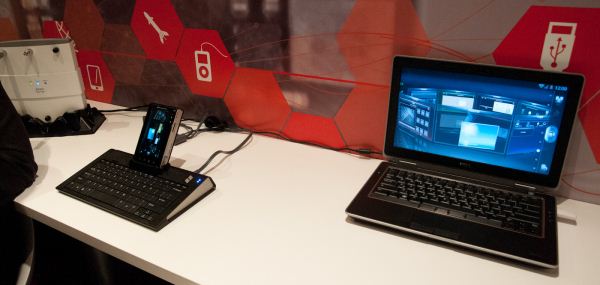
On our last day at MWC 2012, TI pulled me aside for a private demonstration of WiFi Display functionality they had only just recently finalized working on their OMAP 5 development platform. The demo showed WiFi Display mirroring working between the development device’s 720p display and an adjacent notebook which was being used as the WiFi Display sink.
TI emphasized that what’s different about their WiFi Display implementation is that it works using the display framebuffer natively and not a memory copy which would introduce delay and take up space. In addition, the encoder being used is the IVA-HD accelerator doing the WiFi Display specification’s mandatory H.264 baseline Level 3.1 encode, not a software encoder running on the application processor. The demo was running mirroring the development tablet’s 720p display, but TI says they could easily do 1080p as well, but would require a 1080p framebuffer to snoop on the host device. Latency between the development platform and display sink was just 15ms - essentially one frame at 60 Hz.
The demonstration worked live over the air at TI’s MWC booth and also used a WiLink 8 series WLAN combo chip. There was some stuttering, however this is understandable given the fact that this demo was using TCP (live implementations will use UDP) and of course just how crowded 2.4 and 5 GHz spectrum is at these conferences. In addition, TI collaborated with Screenovate for their application development and WiFi Display optimization secret sauce, which I’m guessing has to do with adaptive bitrate or possibly more.
Enabling higher than 480p software encoded WiFi Display is just one more obvious piece of the puzzle which will eventually enable smartphones and tablets to obviate standalone streaming devices.
-----
Personal Comment:
Kind of obvious and interesting step forward as it is more and more requested by mobile devices users to be able to beam or 'to TV' mobile device's screens... which should lead to transform any (mobile) device in a full-duplex video broadcasting enabled device (user interaction included!) ... and one may then succeed in getting rid of some cables in the same sitting?!
Quicksearch
Popular Entries
- The great Ars Android interface shootout (130697)
- Norton cyber crime study offers striking revenue loss statistics (100976)
- MeCam $49 flying camera concept follows you around, streams video to your phone (99706)
- Norton cyber crime study offers striking revenue loss statistics (57205)
- The PC inside your phone: A guide to the system-on-a-chip (56996)
Categories
Show tagged entries
Syndicate This Blog
Calendar
|
|
December '25 | |||||
| Mon | Tue | Wed | Thu | Fri | Sat | Sun |
| 1 | 2 | 3 | 4 | 5 | 6 | 7 |
| 8 | 9 | 10 | 11 | 12 | 13 | 14 |
| 15 | 16 | 17 | 18 | 19 | 20 | 21 |
| 22 | 23 | 24 | 25 | 26 | 27 | 28 |
| 29 | 30 | 31 | ||||



